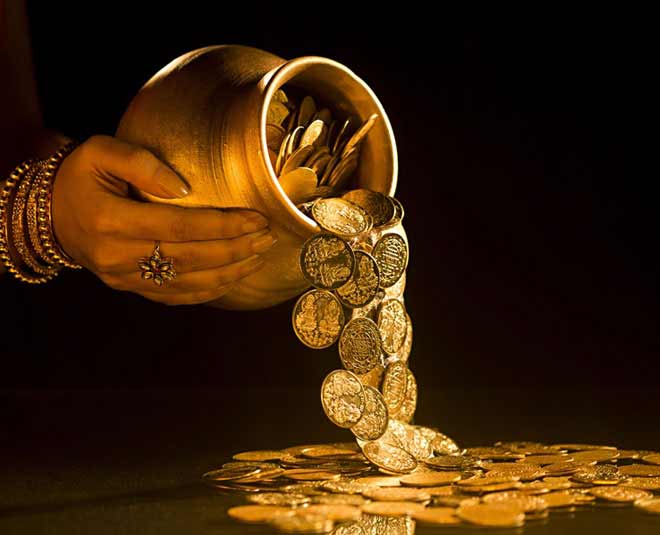Dhanteras (also known as Dhantrayodashi), a Hindu festival celebrated on the 13th day of month of Ashwin, as per Hindu Lunar calendar, has immense importance in the economic history of India.
Dhanteras is named after Bhagvan Dhanvantari, the presiding deity on Ayurveda and Vaidya of Devas. The Ministry of Ayurveda, Yoga & Naturopathy, Unani, Siddha, Sowa Rigpa and Homoeopathy (AYUSH) has also declared the day of Dhanteras ad National Ayurveda Day.
It is believed that Dhanvantari emerged out of sea after Samudramathan with Kalash of elixir in one hand and book on Ayurveda in the other. It is believed that a healthy life is must for wealth creation and therefore God of health is worshiped before God of wealth. The concept of ‘health is wealth’ prevailed in India since time immemorial.
The day marks the beginning of Diwali festivities like Lakshmi Puja and Bhaidooj. Dhanvantari is said to be brother of Devi Lakhsami. The day of Dhanteras is followed by Diwali when people worship Devi Lakshmi who is Goddess of Wealth and Bhagwan Kuber- the God of Wealth.
People generally buy precious metal (Golden, Silver) on Dhanteras and it is believed that anything purchased on the day gives 13 times return. Diyas are placed at doorways of homes as offering to Bhagvan Yama- God of Death. It is believed that the offering of Diyas to Bhagvan Yama averts untimely death, which is essential for wealth creation. The houses are cleaned to welcome Goddess Lakshmi.
Dhanteras is a unique festival, and a gem of Hindu civilizational value. The festival is celebrated a few months after Kharif season (June to October) is over. Therefore, farmers who are the backbone of India’s consumption cycle, have money to spend. The Indian consumer goes on a spending spree on Dhanteras. People buy different goods like car, house, precious metal (Gold, Silver, and diamond), and utensils on the occasion of Dhanteras.
The employees get appraisals and Diwali bonus on the occasion and this is one of the reasons that, not only farmers have disposable income but the employees in Industrial and Services cycle could also afford to loosen pockets. The business owners earn profit with increased consumption expenditure and they also invest in new projects.
The Dhanteras festival starts a virtuous cycle in the Indian economy. It is the impact of Diwali festivities that Indian economy operates in a unique consumption cycle. The Private Final Consumption Expenditure (PFCE), which accounts for 50-60 percent (varies in different quarters) of India’s GDP, gets a significant boost in the Diwali month.
The companies launch new products a few months before Diwali and offer heavy discounts to increase sales. E-commerce companies like Amazon and Flipkart’s quarterly results gets heavily impacted due to the date of Diwali. Sales vary depending on whether Diwali falls in the month of September (second quarter of financial year and third quarter of calendar year) or October (third quarter of FY and fourth quarter of calendar year).
Last year, Amazon’s CFO had to release a statement that company’s dismal performance in the third quarter was due shifting in Diwali’s dates. “There’s material change in the Diwali calendar in India,” said chief financial officer Brian Olsavsky. “About half of our Diwali sales last year were in Q3. This year they will be fully in Q4. So, those are a couple factors that hit the internaional growth area in particular,” he added. The quarterly results of companies depend on the date of Diwali. This is the scale of impact Dhanteras and Diwali on Indian corporates and macro economy.
It is important that government takes step to ‘Indianize’ policymaking because traditions have significant impact on economy. The BJP government has already taken some steps to incorporate behavioral economics in policymaking.
The latest step towards this direction was seen when Union Finance Minister Nirmala Sitharaman broke the centuries old British tradition of carrying the budget speech in a leather briefcase. She carried the budget in bahi-khata (ledger). This was a small step but the symbolisms of it towards Indianization are far reaching.
“It symbolises our departure from the slavery of Western thought. It is not a budget but a bahi-khata (ledger),” said Chief Economic Advisor Krishnamurthy Subramanian.
Economic Survey, the document which sets the tone for policy-making by the government in the upcoming years and analyses the ‘state of the economy’ was also Indianized this year. It drew inspiration from ancient Indian traditions, epics, literature and culture to set the tone for policy-making.
The Economic Survey clearly says the behavioral economics will be the guiding force of policy-making in upcoming years which means the Indian traditions, popular imagination, literature, ancient wisdom on politics and economics will be used to bring positive changes in the life of the people.
“In Hinduism, non-payment of debts is a sin and also a crime,” said the survey on nonpayment of debt by willful defaulters which is major reason behind huge NPA pileup.
“Men in ancient Indian society were identified with their mothers, Yashoda-Nandan, Kaushalya-Nandan, Gandhari-Putra, as well as their wives/consorts, Janaki-Raman, Radha-Krishna,” the survey stated on the issue of Women empowerment.
The kind efficiency that could be achieved by Indianizing policy-making is huge. The festivals like Dhanteras signify the India’s attitude towards wealth creation. Embracing such traditions is important for India to become economic superpower.
